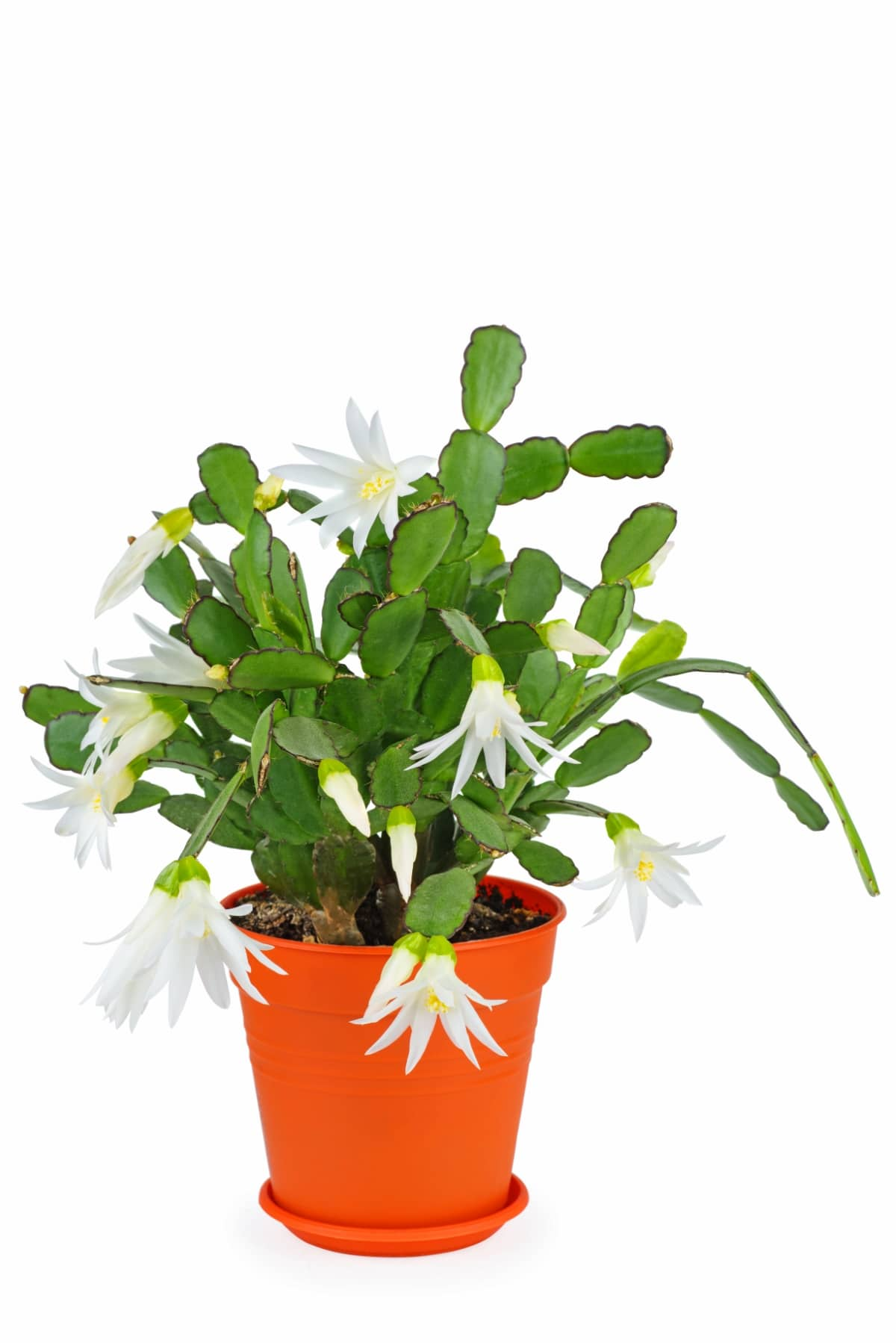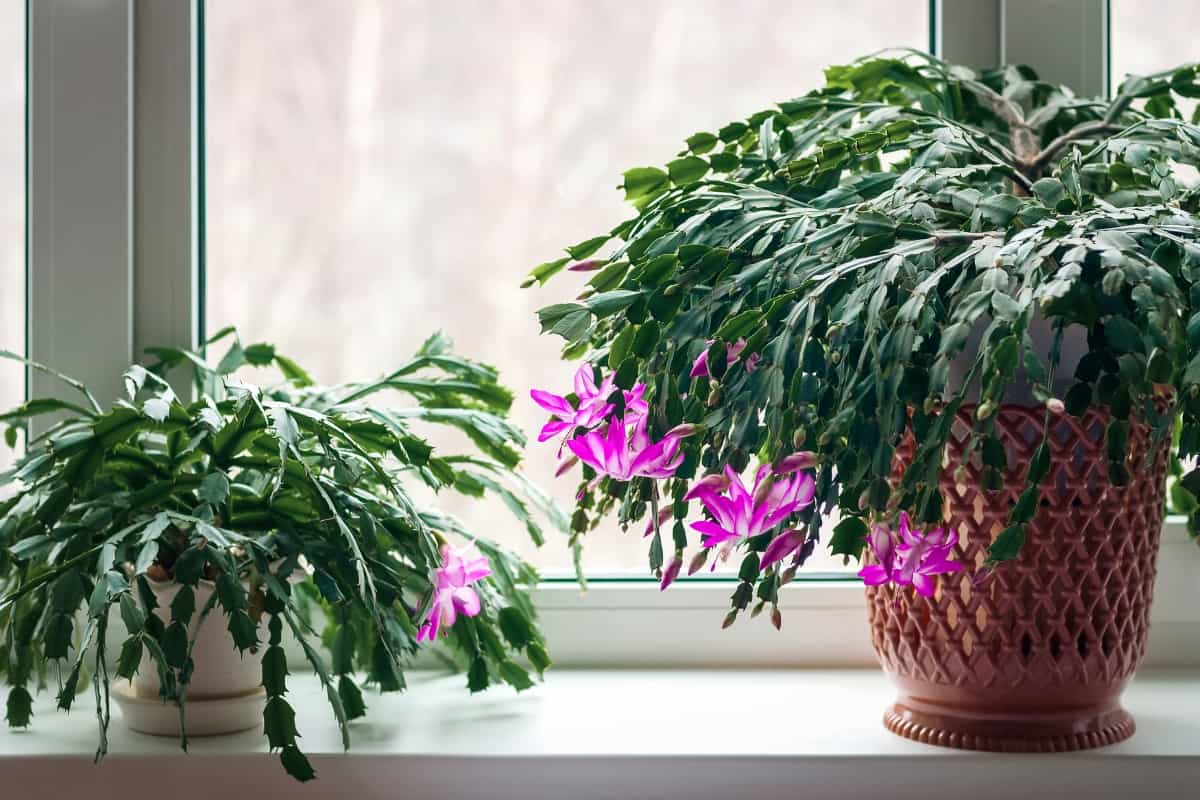When you hear the word ‘cactus,’ you likely picture a prickly desert plant thriving in scorching heat and arid conditions. However, the Christmas cactus is a unique kind that defies these stereotypical characteristics. With its lovely segmented leaves and vibrant tubular flowers that bloom during the holiday season, a Christmas cactus adds a lively pop of color to your indoor garden. If you want to cultivate this stunning houseplant, here we learn everything you need to know about its requirements and care.

How to Grow and Care for a Christmas Cactus
Understanding the Soil Requirements for Christmas Cactus
The first step in successfully growing a Christmas cactus is understanding its soil preferences. Unlike desert cacti, Christmas cacti are native to the coastal mountains of Brazil, where they grow in humid and shady areas. Consequently, their soil needs differ significantly from those of typical cacti.
Your Christmas cactus will flourish in a well-draining soil mixture that retains moisture but doesn’t become waterlogged. You can use a regular potting mix supplemented with perlite, which improves drainage and aeration. Alternatively, you may opt for a soil mix specifically designed for succulents and cacti, which typically contains the right components to maintain a well-draining environment.
Propagation Techniques for Christmas Cactus
One delight of growing a Christmas cactus is the ease with which it can be propagated. The most common and simplest method involves using stem cuttings. Choose a healthy stem from your plant, ideally with 2-3 segments, and gently twist it off. Leave the cutting for a few days to dry, which allows a callus to form over the cut end.
This process helps to prevent the cutting from rotting when you plant it. Post anticipation, insert the cutting approximately one inch into a moistened, compact pot. Verify the cutting’s orientation, aligning with the parent plant’s upward-facing side. Situate the pot in a brightly illuminated location, avoiding direct sunlight, and maintain mildly damp soil conditions. In several weeks, root formation suggests propagation has been successful.
Optimal Light Conditions for Christmas Cactus
Light is a critical factor in maintaining a healthy Christmas cactus. While these plants can handle some direct sunlight, they prefer bright, indirect light. Excessive sunlight may result in reddening or burning of their leaves, whereas inadequate light can impede flowering. Find a place in your home that receives much natural light but is shielded from harsh afternoon sunlight. An east or north-facing window could be a perfect spot. If your home lacks natural light, you can supplement it with fluorescent lights.
Temperature and Humidity for Christmas Cactus
Christmas cacti are tropical plants and prefer similar conditions: warm but not hot temperatures and high humidity. During their growth period, typically in spring and summer, these plants thrive best within a temperature bracket of 70 to 80 degrees Fahrenheit. Reducing the temperature to about 55 to 65 degrees as fall approaches can encourage the cactus to bloom.
In case you missed it: Tree, Houseplant, and Shrub Fertilizer Spikes: Everything You Need to Know About

As for humidity, Christmas cacti thrive in a more humid environment than many other houseplants. Enhance your cactus’s environment by placing its container on a tray with pebbles and a slight amount of water if the indoor air is arid. The water’s evaporation will escalate the surrounding humidity. Verify that the pot base doesn’t contact the water.
Watering Requirements for Christmas Cactus
Like other succulents, Christmas cacti store water in their leaves and can survive periods of drought. However, they prefer a more regular watering schedule than most desert cacti. Maintain moderate soil moisture in spring and summer. Water your Christmas cactus when the top inch of soil dries out. Ensure complete hydration, but allow surplus water to drain.
Avoid waterlogged conditions to prevent root rot. As you start preparing the plant for blooming in the fall, reduce the watering frequency. Let the soil dry out a bit more between watering. During the plant’s winter blooming phase, provide minimal hydration, sufficient only to prevent the soil from fully dehydrating.
Growing Christmas Cactus Indoors
Christmas cacti are perfect houseplants. They do not take up much space, and their minimal care requirements make them a great choice for indoor gardening beginners and experienced plant owners alike. As discussed, the key elements to consider when growing Christmas cactus indoors include providing the right soil, light, temperature, and humidity conditions. Furthermore, please ensure adequate space for plant growth.
While Christmas cacti are not rapid growers, they can reach a considerable size over several years. Choose a pot that provides enough room for the plant’s root system to grow, but avoid going too large, as too much soil can hold excess water and lead to root problems.
Fertilizing Your Christmas Cactus
Like all plants, Christmas cacti benefit from regular feeding to promote growth and blooming. Use a well-balanced houseplant fertilizer and follow the packaging instructions. The best time to fertilize is during the growing season. Begin nutrient supplementation in the latter part of winter or the onset of spring and sustain through summer. Stop fertilization in late summer provides the plant a respite before its winter flowering phase. Remember, when it comes to fertilizing, less is more. Over-fertilizing can harm the plant and burn the roots. If you’re in doubt, err on caution and use less rather than more.
Repotting a Christmas Cactus
Repotting your Christmas cactus can give it more space to grow and rejuvenate its soil. However, these plants prefer to be root-bound and don’t need repotting often. A good rule of thumb is to repot every 2-3 years or when the plant outgrows its current pot. The best time to do this is in early spring.
For repotting, select a container marginally bigger than the existing one, having efficient drainage holes. Carefully extract the plant from its previous pot, discard extra soil, and position it in the new container. Fill in with fresh potting mix, ensuring the plant is at the same depth as in the previous pot.
Pruning and Shaping a Christmas Cactus
Pruning your Christmas cactus can keep it healthy and promote bushier growth. The best time to prune is late winter or early spring after blooming. Pruning a Christmas cactus is simple. You can pinch a few segments from each stem with your fingers. The removed segments can be used for propagation, as described earlier. It’s a win-win situation: you shape your plant and get more plants.
In case you missed it: Benefits of Baking Soda for Houseplants

Conclusion
The Christmas cactus is a delightful houseplant to grow. It may have different care requirements than the average cactus. Still, with some understanding and attention, you can cultivate a Christmas cactus and enjoy its magnificent bloom year after year.
- Feed Your Flock for Less: Top 10 Tips to Save on Chicken Feed
- Ultimate Guide to Ossabaw Island Hog: Breeding, Raising, Diet, and Care
- Hatching Answers: The Top 10 Reasons Your Chickens Aren’t Laying Eggs
- Eggs and Economics: Breaking Down the Cost of Raising Backyard Chickens
- Defend Your Greens: Proven Methods to Keep Iguanas Out of Your Garden
- Ultimate Guide to Cinnamon Queen Chicken: A Comprehensive Guide for Beginners
- Ultimate Guide to California Tan Chicken: Breeding, Raising, Diet, Egg-Production and Care
- Ultimate Guide to Marsh Daisy Chicken: Breeding, Raising, Diet, and Care
- 10 Types of Chicken Farming Businesses You Can Start for Profits